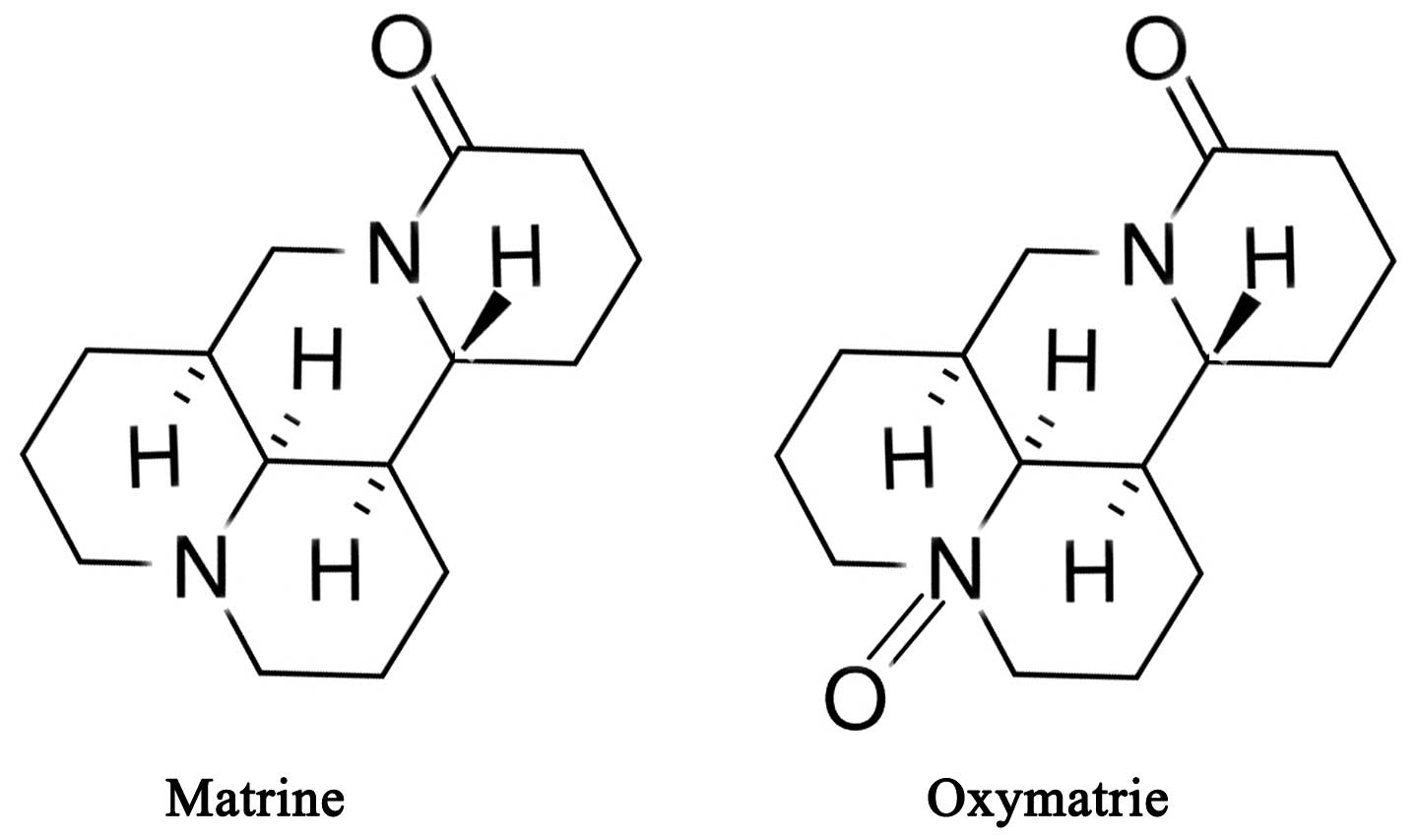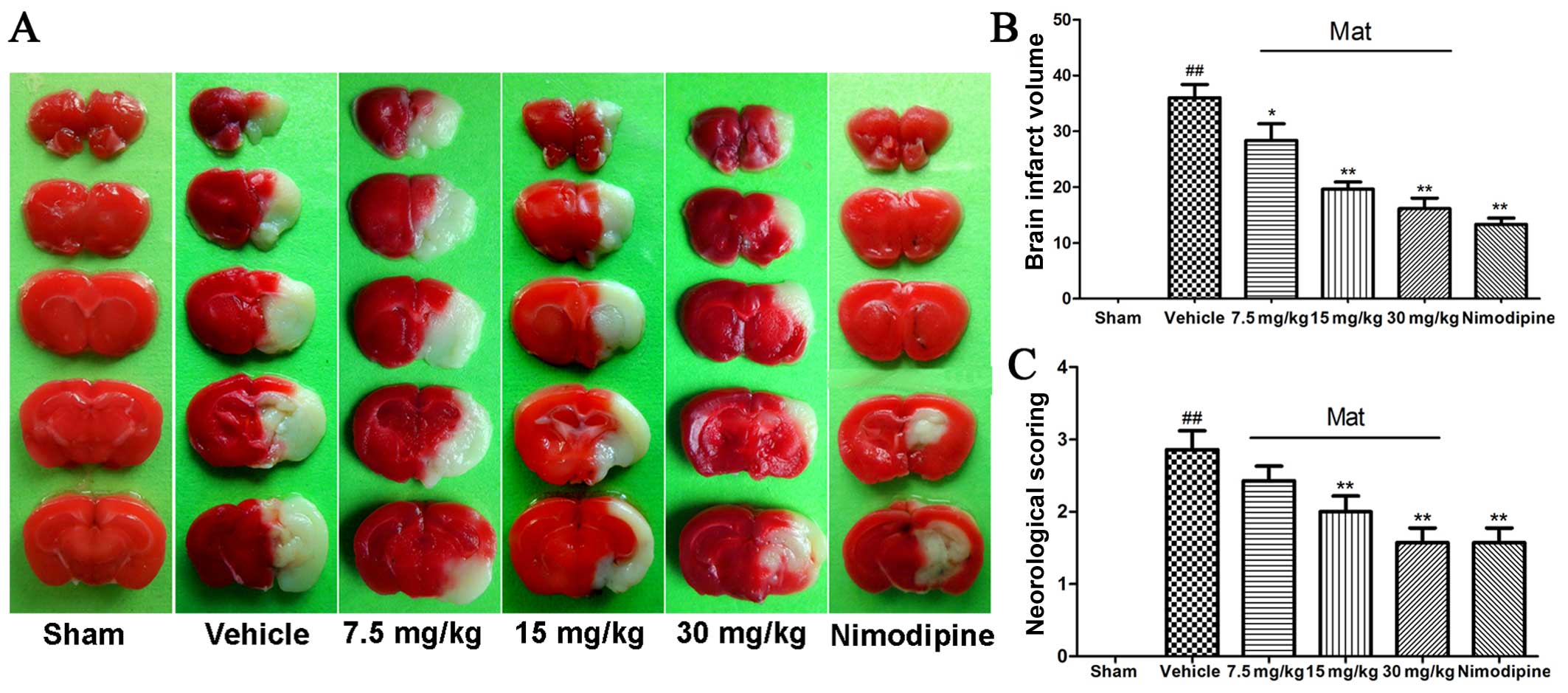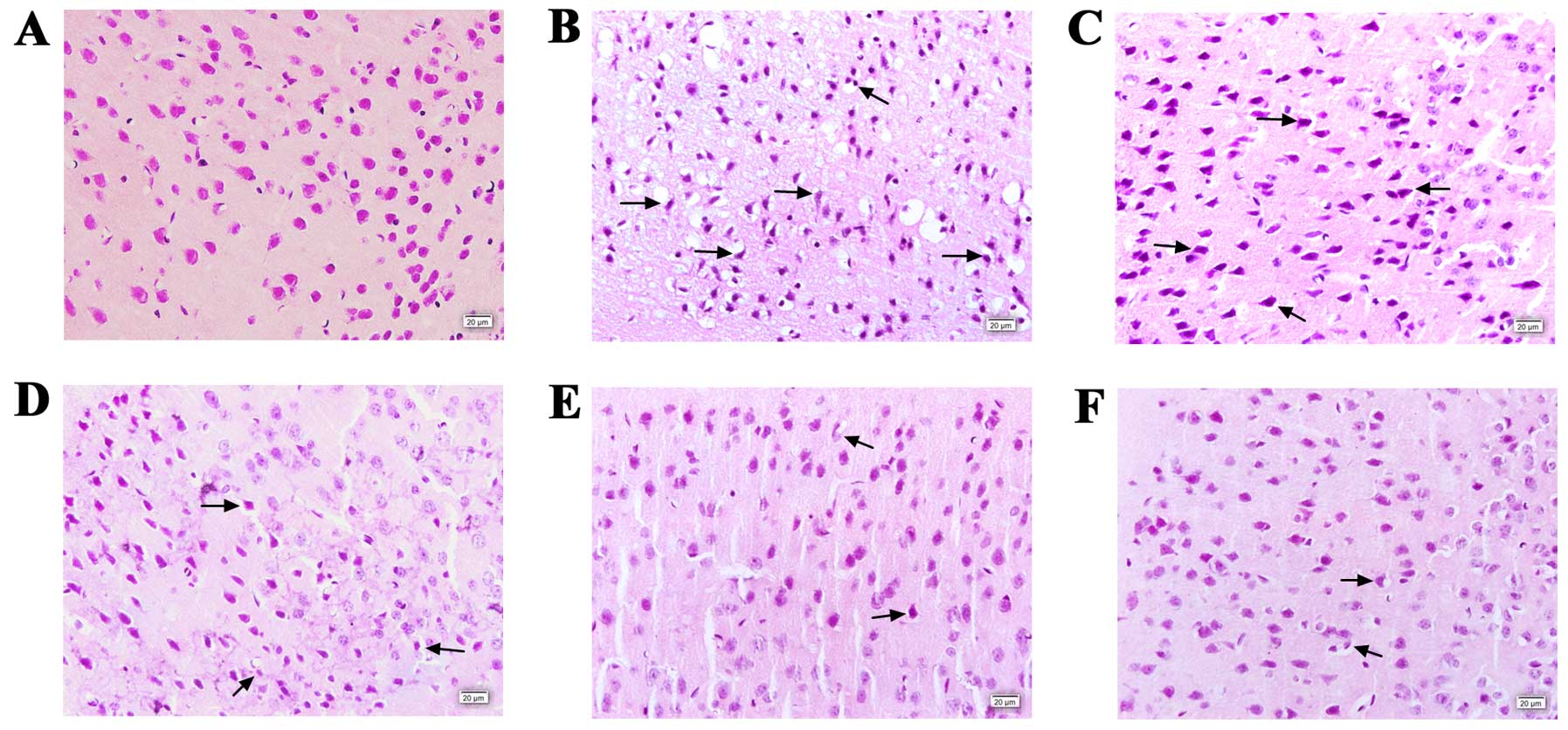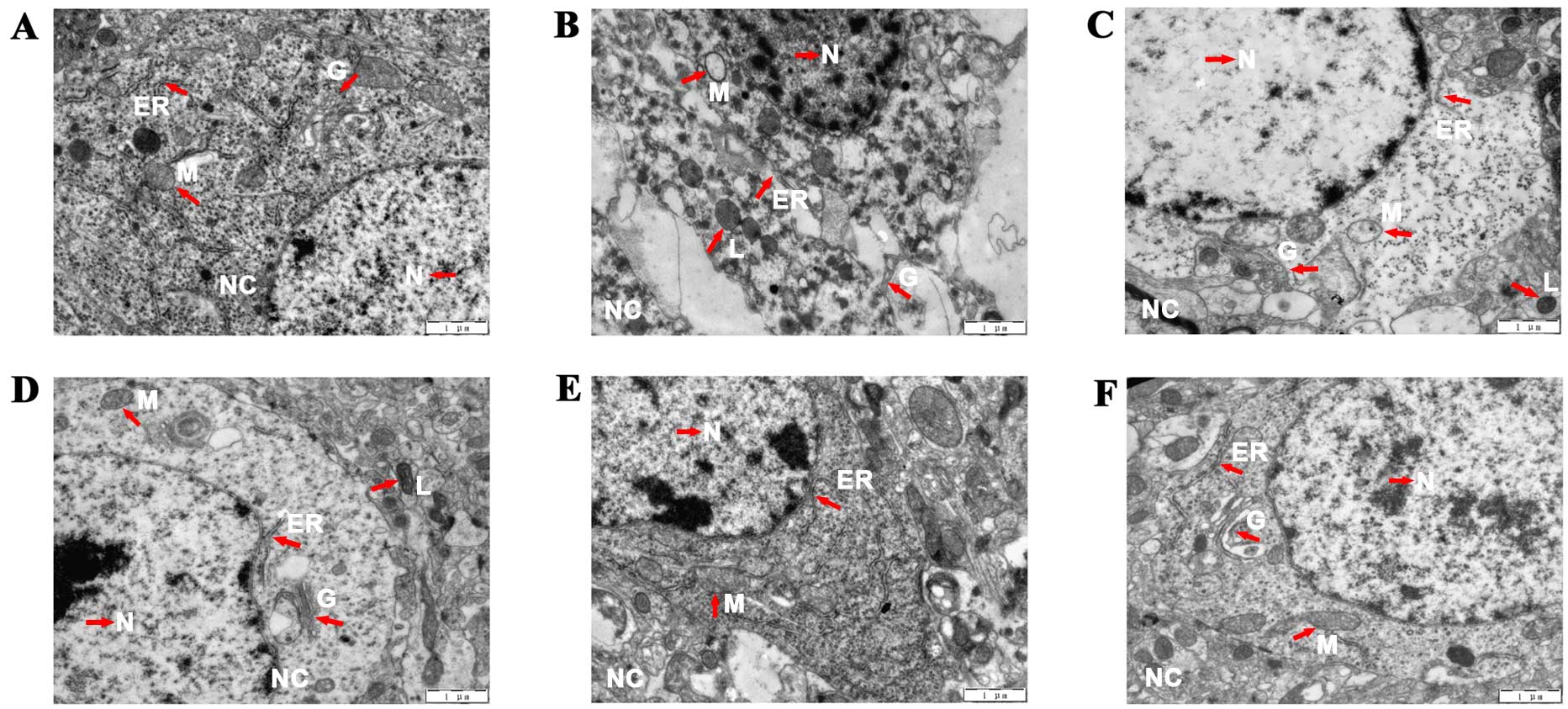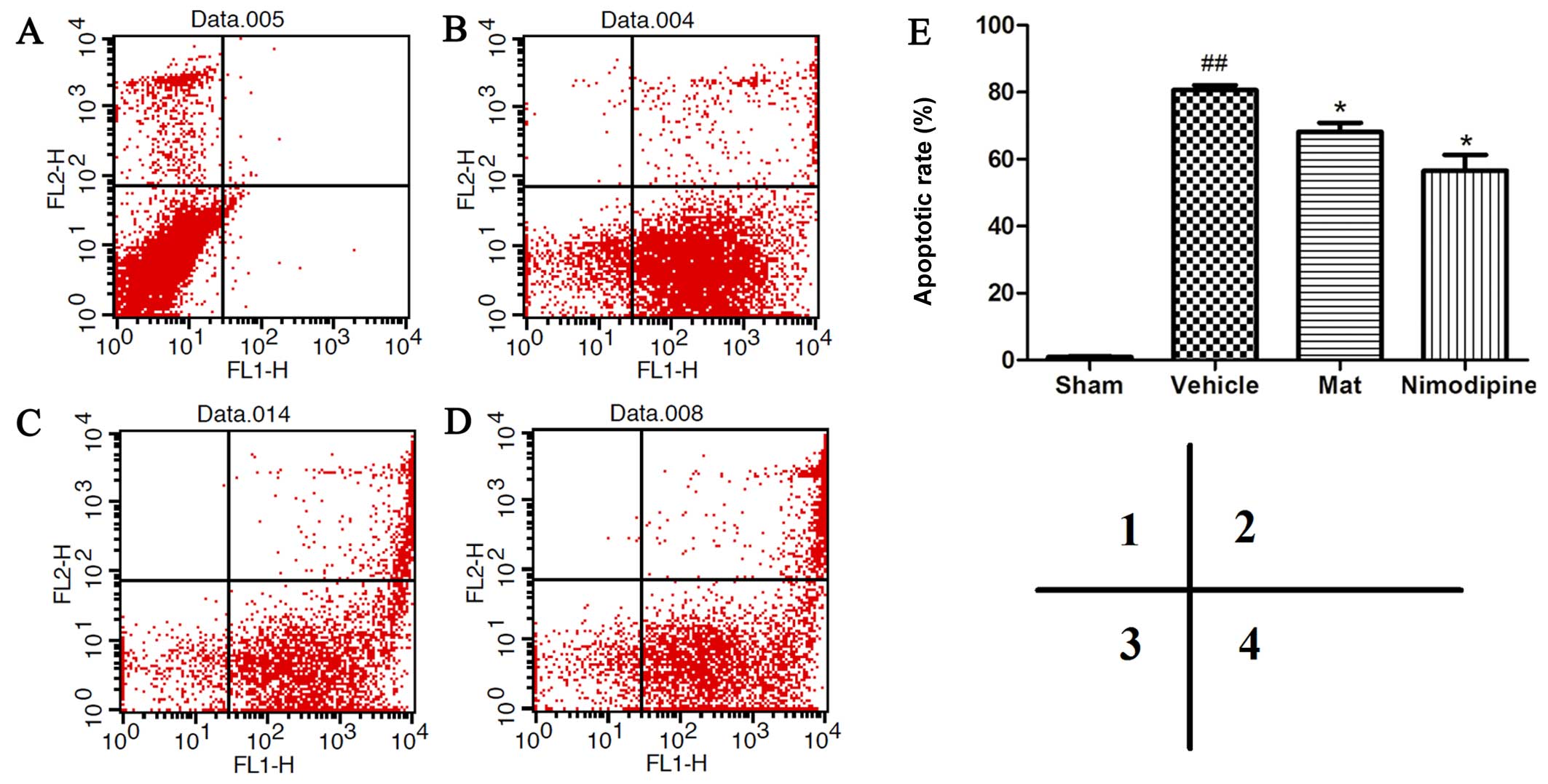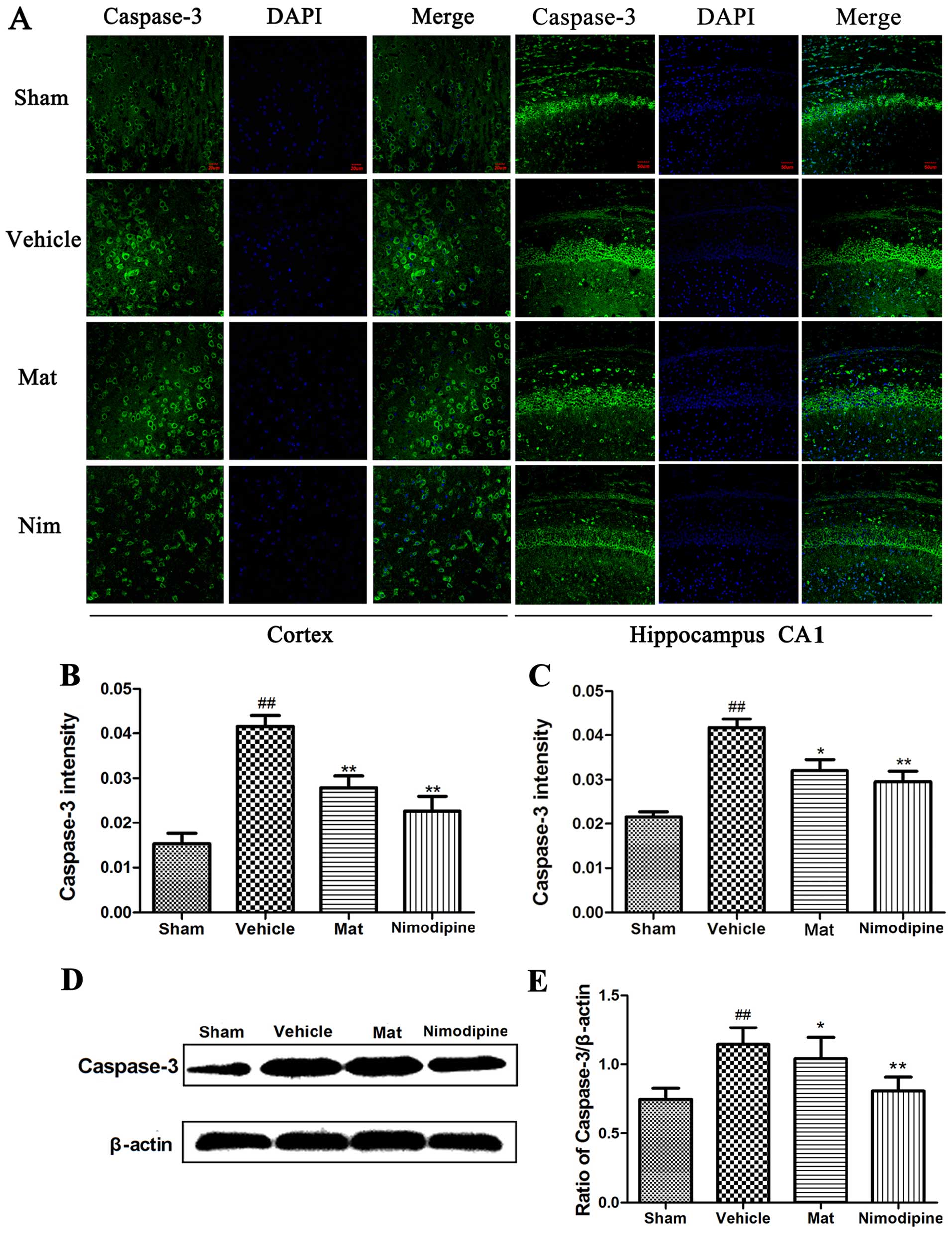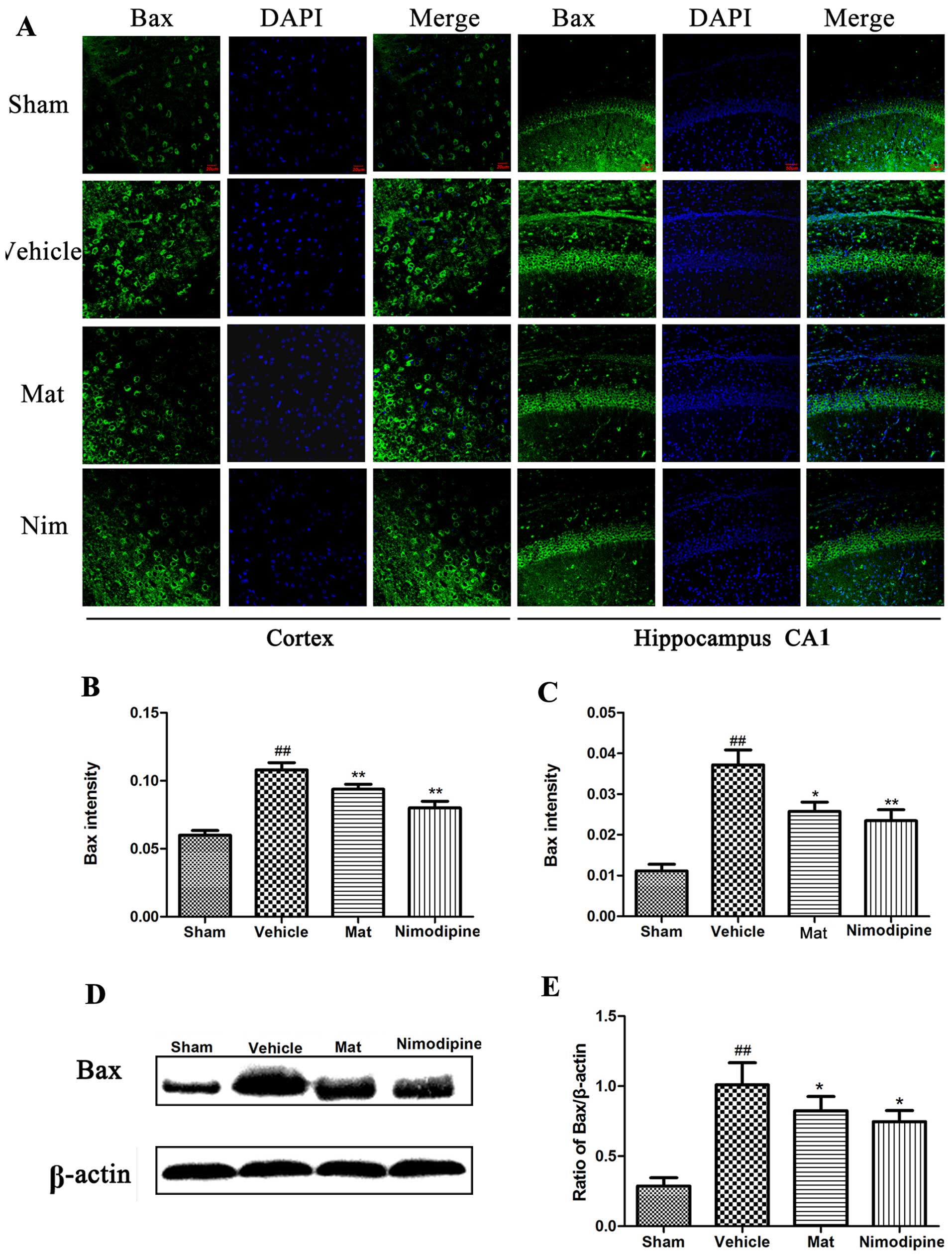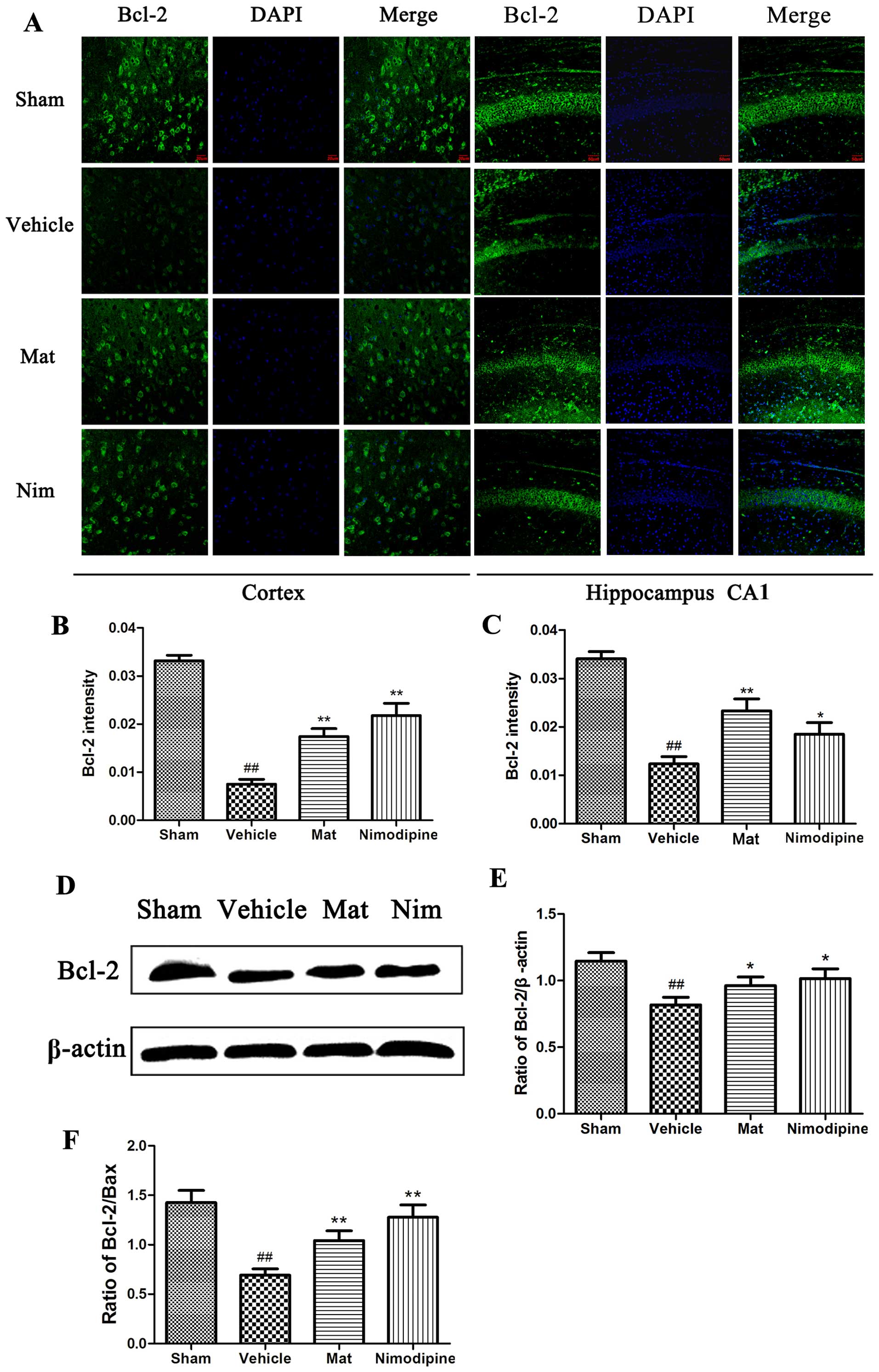|
1
|
Liu Y, Zhang XJ, Yang CH and Fan HG:
Oxymatrine protects rat brains against permanent focal ischemia and
downregulates NF-kappaB expression. Brain Res. 1268:174–180. 2009.
View Article : Google Scholar : PubMed/NCBI
|
|
2
|
Xu Q, Yang JW, Cao Y, Zhang LW, Zeng XH,
Li F, Du SQ, Wang LP and Liu CZ: Acupuncture improves locomotor
function by enhancing GABA receptor expression in transient focal
cerebral ischemia rats. Neurosci Lett. 588:88–94. 2015. View Article : Google Scholar : PubMed/NCBI
|
|
3
|
Yao Y, Chen L, Xiao J, Wang C, Jiang W,
Zhang R and Hao J: Chrysin protects against focal cerebral
ischemia/reperfusion injury in mice through attenuation of
oxidative stress and inflammation. Int J Mol Sci. 15:20913–20926.
2014. View Article : Google Scholar : PubMed/NCBI
|
|
4
|
Jiang M, Li J, Peng Q, Liu Y, Liu W, Luo
C, Peng J, Li J, Yung KK and Mo Z: Neuroprotective effects of
bilobalide on cerebral ischemia and reperfusion injury are
associated with inhibition of pro-inflammatory mediator production
and down-regulation of JNK1/2 and p38 MAPK activation. J
Neuroinflammation. 11:1672014. View Article : Google Scholar : PubMed/NCBI
|
|
5
|
Ma Y, Li Y, Zhang C, Zhou X and Wu Y:
Neuroprotective effect of 4-methylcyclopentadecanone on focal
cerebral ischemia/reperfusion injury in rats. J Pharmacol Sci.
125:320–328. 2014. View Article : Google Scholar : PubMed/NCBI
|
|
6
|
Zhang L, Zhao H, Zhang X, Chen L, Zhao X,
Bai X and Zhang J: Nobiletin protects against cerebral ischemia via
activating the p-Akt, p-CREB, BDNF and Bcl-2 pathway and
ameliorating BBB permeability in rat. Brain Res Bull. 96:45–53.
2013. View Article : Google Scholar : PubMed/NCBI
|
|
7
|
Tabassum R, Vaibhav K, Shrivastava P, Khan
A, Ahmed ME, Ashafaq M, Khan MB and Islam F, Safhi MM and Islam F:
Perillyl alcohol improves functional and histological outcomes
against ischemia-reperfusion injury by attenuation of oxidative
stress and repression of COX-2, NOS-2 and NF-κB in middle cerebral
artery occlusion rats. Eur J Pharmacol. 747:190–199. 2015.
View Article : Google Scholar
|
|
8
|
Micieli G, Marcheselli S and Tosi PA:
Safety and efficacy of alteplase in the treatment of acute ischemic
stroke. Vasc Health Risk Manag. 5:397–409. 2009. View Article : Google Scholar : PubMed/NCBI
|
|
9
|
Xu YQ, Jin SJ, Liu N, Li YX, Zheng J, Ma
L, Du J, Zhou R, Zhao CJ, Niu Y, et al: Aloperine attenuated
neuropathic pain induced by chronic constriction injury via
anti-oxidation activity and suppression of the nuclear factor kappa
B pathway. Biochem Biophys Res Commun. 451:568–573. 2014.
View Article : Google Scholar : PubMed/NCBI
|
|
10
|
Wang T, Li Y, Wang Y, Zhou R, Ma L, Hao Y,
Jin S, Du J, Zhao C, Sun T, et al: Lycium barbarumpolysaccharide
prevents focal cerebral ischemic injury by inhibiting neuronal
apoptosis in mice. PLoS One. 9:e907802014. View Article : Google Scholar
|
|
11
|
Dong XQ, Du Q, Yu WH, Zhang ZY, Zhu Q, Che
ZH, Chen F, Wang H and Chen J: Anti-inflammatory effects of
oxymatrine through inhibition of nuclear factor-kappa B and
mitogen-activated protein kinase activation in
lipopolysaccharide-induced BV2 microglia cells. Iran J Pharm Res.
12:165–174. 2013.PubMed/NCBI
|
|
12
|
Cao HW, Zhang H, Chen ZB, Wu ZJ and Cui
YD: Chinese traditional medicine matrine: A review of its antitumor
activities. J Med Plants Res. 5:1806–1810. 2011.
|
|
13
|
Zhang HF, Shi LJ, Song GY, Cai ZG, Wang C
and An RJ: Protective effects of matrine against progression of
high-fructose diet-induced steatohepatitis by enhancing antioxidant
and anti-inflammatory defences involving Nrf2 translocation. Food
Chem Toxicol. 55:70–77. 2013. View Article : Google Scholar : PubMed/NCBI
|
|
14
|
Long Y, Lin XT, Zeng KL and Zhang L:
Efficacy of intramuscular matrine in the treatment of chronic
hepatitis B. Hepatobiliary Pancreat Dis Int. 3:69–72.
2004.PubMed/NCBI
|
|
15
|
Hu ZL, Tan YX, Zhang JP and Qian DH:
Effects of inhibitor of protein kinase C on brain edema formation
evoked by experimental cerebral ischemia in gerbils and rats. Yao
Xue Xue Bao. 31:886–890. 1996.In Chinese.
|
|
16
|
Xu M, Yang L, Hong LZ, Zhao XY and Zhang
HL: Direct protection of neurons and astrocytes by matrine via
inhibition of the NF-κB signaling pathway contributes to
neuroprotection against focal cerebral ischemia. Brain Res.
1454:48–64. 2012. View Article : Google Scholar : PubMed/NCBI
|
|
17
|
Hong-Li S, Lei L, Lei S, Dan Z, De-Li D,
Guo-Fen Q, Yan L, Wen-Feng C and Bao-Feng Y: Cardioprotective
effects and underlying mechanisms of oxymatrine against Ischemic
myocardial injuries of rats. Phytother Res. 22:985–989. 2008.
View Article : Google Scholar : PubMed/NCBI
|
|
18
|
Jiang H, Meng F, Li J and Sun X:
Anti-apoptosis effects of oxymatrine protect the liver from warm
ischemia reperfusion injury in rats. World J Surg. 29:1397–1401.
2005. View Article : Google Scholar : PubMed/NCBI
|
|
19
|
Zhao J, Yu S, Tong L, Zhang F, Jiang X,
Pan S, Jiang H and Sun X: Oxymatrine attenuates intestinal
ischemia/reperfusion injury in rats. Surg Today. 38:931–937. 2008.
View Article : Google Scholar : PubMed/NCBI
|
|
20
|
Park SJ, Nam KW, Lee HJ, Cho EY, Koo U and
Mar W: Neuroprotective effects of an alkaloid-free ethyl acetate
extract from the root of Sophora flavescens Ait. against focal
cerebral ischemia in rats. Phytomedicine. 16:1042–1051. 2009.
View Article : Google Scholar : PubMed/NCBI
|
|
21
|
Zhang K, Li YJ, Yang Q, Gerile O, Yang L,
Li XB, Guo YY, Zhang N, Feng B, Liu SB, et al: Neuroprotective
effects of oxymatrine against excitotoxicity partially through
down-regulation of NR2B-containing rceptors. Phytomedicine.
20:343–350. 2013. View Article : Google Scholar
|
|
22
|
Yu J, Yang S, Wang X and Gan R: Matrine
improved the function of heart failure in rats via inhibiting
apoptosis and blocking β3 adrenoreceptor/endothelial nitric oxide
synthase pathway. Mol Med Rep. 10:3199–3204. 2014.PubMed/NCBI
|
|
23
|
Longa EZ, Weinstein PR, Carlson S and
Cummins R: Reversible middle cerebral artery occlusion without
craniectomy in rats. Stroke. 20:84–91. 1989. View Article : Google Scholar : PubMed/NCBI
|
|
24
|
Bederson JB, Pitts LH, Tsuji M, Nishimura
MC, Davis RL and Bartkowski H: Rat middle cerebral artery
occlusion: evaluation of the model and development of a neurologic
examination. Stroke. 17:472–476. 1986. View Article : Google Scholar : PubMed/NCBI
|
|
25
|
Okuno S NH and Sakaki T: Comparative study
of 2,3,5-triphenyltetrazolium chloride (TTC) and hematoxylin-eosin
staining for quantification of early brain ischemic injury in cats.
Neurol Res. 23:657–661. 2001. View Article : Google Scholar : PubMed/NCBI
|
|
26
|
Wang HB, Li YX, Hao YJ, Wang TF, Lei Z, Wu
Y, Zhao QP, Ang H, Ma L, Liu J, et al: Neuroprotective effects of
LBP on brain ischemic reperfusion neurodegeneration. Eur Rev Med
Pharmacol Sci. 17:2760–2765. 2013.PubMed/NCBI
|
|
27
|
Gilgun-Sherki Y, Rosenbaum Z, Melamed E
and Offen D: Antioxidant therapy in acute central nervous system
injury: Current state. Pharmacol Rev. 54:271–284. 2002. View Article : Google Scholar : PubMed/NCBI
|
|
28
|
Liu R, Gao M, Yang ZH and Du GH:
Pinocembrin protects rat brain against oxidation and apoptosis
induced by ischemia-reperfusion both in vivo and in vitro. Brain
Res. 1216:104–115. 2008. View Article : Google Scholar : PubMed/NCBI
|
|
29
|
Chan PH: Reactive oxygen radicals in
signaling and damage in the ischemic brain. J Cereb Blood Flow
Metab. 21:2–14. 2001. View Article : Google Scholar : PubMed/NCBI
|
|
30
|
Kontos HA: Oxygen radicals in cerebral
ischemia: The 2001 Willis lecture. Stroke. 32:2712–2716. 2001.
View Article : Google Scholar : PubMed/NCBI
|
|
31
|
Dröge W: Free radicals in the
physiological control of cell function. Physiol Rev. 82:47–95.
2002. View Article : Google Scholar : PubMed/NCBI
|
|
32
|
Zimmermann C, Winnefeld K, Streck S,
Roskos M and Haberl RL: Antioxidant status in acute stroke patients
and patients at stroke risk. Eur Neurol. 51:157–161. 2004.
View Article : Google Scholar : PubMed/NCBI
|
|
33
|
Ozkan A, Sen HM, Sehitoglu I, Alacam H,
Guven M, Aras AB, Akman T, Silan C, Cosar M and Karaman HI:
Neuroprotective effect of humic Acid on focal cerebral ischemia
injury: An experimental study in rats. Inflammation. 38:32–39.
2015. View Article : Google Scholar
|
|
34
|
Chen H, Yoshioka H, Kim GS, Jung JE, Okami
N, Sakata H, Maier CM, Narasimhan P, Goeders CE and Chan PH:
Oxidative stress in ischemic brain damage: Mechanisms of cell death
and potential molecular targets for neuroprotection. Antioxid Redox
Signal. 14:1505–1517. 2011. View Article : Google Scholar :
|
|
35
|
Yuan J and Yankner BA: Apoptosis in the
nervous system. Nature. 407:802–809. 2000. View Article : Google Scholar : PubMed/NCBI
|
|
36
|
Kong LL, Wang ZY, Hu JF, Yuan YH, Han N,
Li H and Chen NH: Inhibition of chemokine-like factor 1 protects
against focal cerebral ischemia through the promotion of energy
metabolism and anti-apoptotic effect. Neurochem Int. 76:91–98.
2014. View Article : Google Scholar : PubMed/NCBI
|
|
37
|
Zhang F, Yin W and Chen J: Apoptosis in
cerebral ischemia: Executional and regulatory signaling mechanisms.
Neurol Res. 26:835–845. 2004. View Article : Google Scholar
|
|
38
|
Li P, Nijhawan D, Budihardjo I,
Srinivasula SM, Ahmad M, Alnemri ES and Wang X: Cytochrome c and
dATP-dependent formation of Apaf-1/caspase-9 complex initiates an
apoptotic protease cascade. Cell. 91:479–489. 1997. View Article : Google Scholar : PubMed/NCBI
|
|
39
|
Li Y, Chopp M, Jiang N, Yao F and Zaloga
C: Temporal profile of in situ DNA fragmentation after transient
middle cerebral artery occlusion in the rat. J Cereb Blood Flow
Metab. 15:389–397. 1995. View Article : Google Scholar : PubMed/NCBI
|
|
40
|
Han BH, D'Costa A, Back SA, Parsadanian M,
Patel S, Shah AR, Gidday JM, Srinivasan A, Deshmukh M and Holtzman
DM: BDNF blocks caspase-3 activation in neonatal hypoxia-ischemia.
Neurobiol Dis. 7:38–53. 2000. View Article : Google Scholar : PubMed/NCBI
|
|
41
|
Gill R, Soriano M, Blomgren K, Hagberg H,
Wybrecht R, Miss MT, Hoefer S, Adam G, Niederhauser O, Kemp JA, et
al: Role of caspase-3 activation in cerebral ischemia-induced
neurodegeneration in adult and neonatal brain. J Cereb Blood Flow
Metab. 22:420–430. 2002. View Article : Google Scholar : PubMed/NCBI
|
|
42
|
Namura S, Zhu J, Fink K, Endres M,
Srinivasan A, Tomaselli KJ, Yuan J and Moskowitz MA: Activation and
cleavage of caspase-3 in apoptosis induced by experimental cerebral
ischemia. J Neurosci. 18:3659–3668. 1998.PubMed/NCBI
|
|
43
|
Peng Z, Wang S, Chen G, Cai M, Liu R, Deng
J, Liu J, Zhang T, Tan Q and Hai C: Gastrodin alleviates cerebral
ischemic damage in mice by improving anti-oxidant and
anti-inflammation activities and inhibiting apoptosis pathway.
Neurochem Res. 40:661–673. 2015. View Article : Google Scholar : PubMed/NCBI
|
|
44
|
Jia D, Han B, Yang S and Zhao J: Anemonin
alleviates nerve injury after cerebral ischemia and reperfusion
(i/r) in rats by improving antioxidant activities and inhibiting
apoptosis pathway. J Mol Neurosci. 53:271–279. 2014. View Article : Google Scholar : PubMed/NCBI
|
|
45
|
Abas F, Alkan T, Goren B, Taskapilioglu O,
Sarandol E and Tolunay S: Neuroprotective effects of
postconditioning on lipid peroxidation and apoptosis after focal
cerebral ischemia/reperfusion injury in rats. Turk Neurosurg.
20:1–8. 2010.PubMed/NCBI
|
|
46
|
Hetz C, Vitte PA, Bombrun A, Rostovtseva
TK, Montessuit S, Hiver A, Schwarz MK, Church DJ, Korsmeyer SJ,
Martinou JC, et al: Bax channel inhibitors prevent
mitochondrion-mediated apoptosis and protect neurons in a model of
global brain ischemia. J Biol Chem. 280:42960–42970. 2005.
View Article : Google Scholar : PubMed/NCBI
|
|
47
|
Sugawara T, Fujimura M, Morita-Fujimura Y,
Kawase M and Chan PH: Mitochondrial release of cytochrome c
corresponds to the selective vulnerability of hippocampal CA1
neurons in rats after transient global cerebral ischemia. J
Neurosci. 19:RC391999.PubMed/NCBI
|
|
48
|
Ma L, Wen S, Zhan Y, He Y, Liu X and Jiang
J: Anticancer effects of the Chinese medicine matrine on murine
hepatocellular carcinoma cells. Planta Med. 74:245–251. 2008.
View Article : Google Scholar : PubMed/NCBI
|
|
49
|
Tan C, Qian X, Jia R, Wu M and Liang Z:
Matrine induction of reactive oxygen species activates p38 leading
to caspase-dependent cell apoptosis in non-small cell lung cancer
cells. Oncol Rep. 30:2529–2535. 2013.PubMed/NCBI
|
|
50
|
Niu H, Zhang Y, Wu B, Zhang Y, Jiang H and
He P: Matrine induces the apoptosis of lung cancer cells through
downregulation of inhibitor of apoptosis proteins and the Akt
signaling pathway. Oncol Rep. 32:1087–1093. 2014.PubMed/NCBI
|















